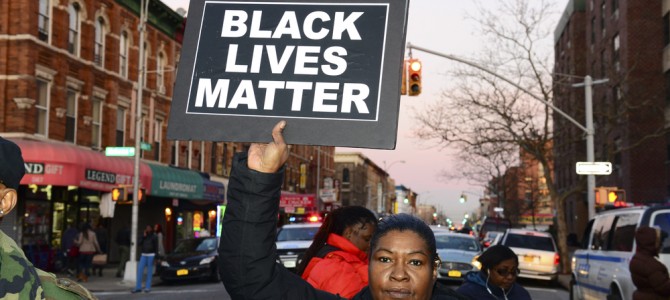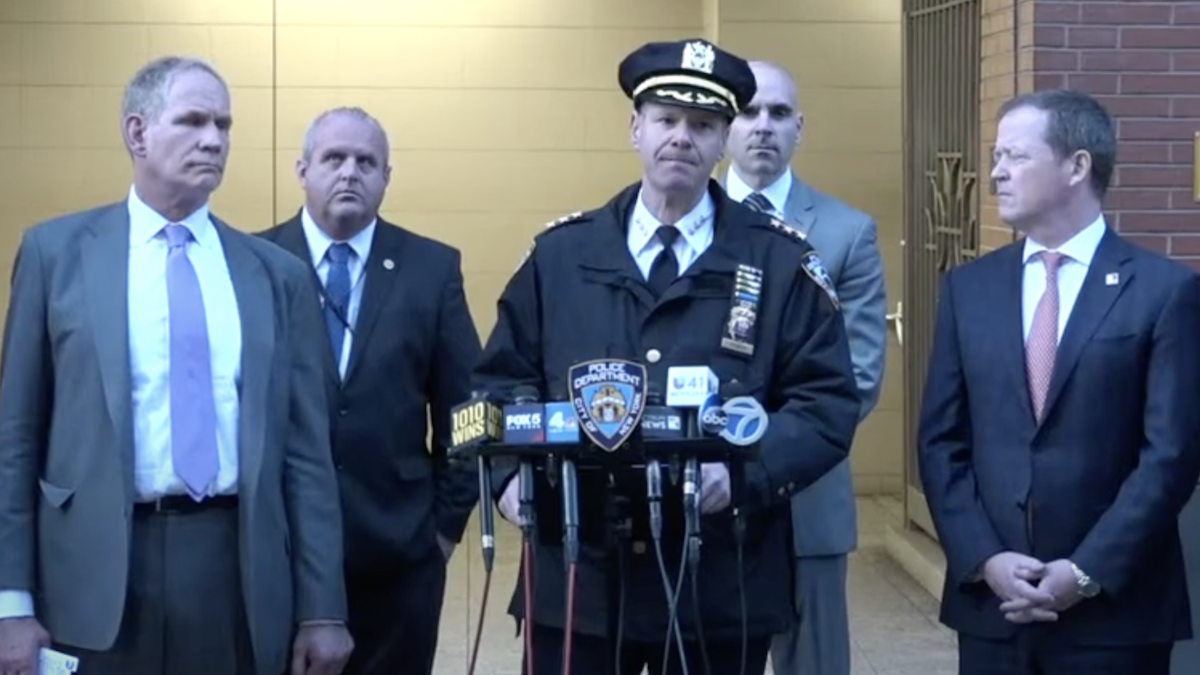
Is it rational for black men to fear they may be killed by police? The Washington Post has just released a new, groundbreaking study on police violence that may help answer that question. It investigates every fatal police shooting in the United States in 2015. You can see the data here.
Plenty of arresting details come out of this study. Those who followed the Tamir Rice case may be interested to know that realistic-looking toy guns were involved in fully 3 percent of the shootings. Almost 10 percent of victims were unarmed when they were killed, and a very disproportionate number of these were black. About a quarter of the suspects were fleeing when they were shot, while a quarter struggled with mental illness.
The headliner, though, is something we already knew: a lot of Americans get killed in police shootings. As of Christmas Eve, police in America had fatally shot 979 people across the United States. (The Guardian, with a similar study, puts the number over 1,000.)
That’s a lot, when you consider that multiple European countries can count on one hand the number of fatal police shootings each year. Every country is different, of course, in innumerable ways. Nevertheless, such enormous disparities should prompt some probing questions.
Are Cops Racist?
This of course is the question on everyone’s mind. The study won’t definitively answer it, but it may help flesh out the picture of what’s really happening in America’s more crime-ridden districts.
Some contend this data puts to rest any reasonable concern about widespread racial bias in America’s police departments. It’s true of course that young, black men are far more likely to be shot and killed by police. That’s easily explicable, however, in terms of disproportionate crime rates, and there’s no evidence that white-on-black violence is in at all disproportionate to levels of crime. David French summarizes the argument neatly as follows:
Crime doesn’t break down on neat, proportionate demographic lines. Criminals are overwhelmingly male (police killed very few women this year, but no one argues that law enforcement is sexist), and violent criminals are disproportionately black. In fact, blacks ‘commit homicide at close to eight times the rate of whites and Hispanics combined.’ Even worse, ‘among males between the ages of 14 and 17, the interracial homicide commission gap is nearly tenfold.’ In 2014, for example, while black Americans constituted only about 13 percent of the population, they represented a majority of the homicide and robbery arrests. 82 percent of all gun deaths in the black community are from homicide. For whites, 77 percent of gun deaths are suicides.
On face, this is a compelling argument. Blacks commit more violent crimes (dramatically more, in fact) than whites. Is it surprising they are disproportionately shot by police? If anything, racial disparities should be seen as a good sign, that police are going after the folks who are really committing crimes.
So if you’re raising a black son in America (so the logic goes), you should simply teach him to be a law-abiding citizen. That should be protection enough from the hazards of law-enforcement.
Black Lives Matter May Still Have A Point
As usual, the obvious explanation is a little too obvious. Let’s consider a slightly more nuanced explanation of the data, which may give some credence to the anxieties of Black Lives Matter, without assuming that police officers are raging bigots.
Black men really are responsible for a wildly disproportionate number of America’s homicides. In some neighborhoods, these mostly go unsolved. They are primarily committed in the context of gang rivalries, and police find these cases challenging to close, because available witnesses are too afraid to testify. (Their families live in these neighborhoods, and are liable to be targeted if witnesses come forward.)
Law enforcement tends to be less aggressive about prosecuting “insider violence” (committed among mafiosos, gangsters, or members of criminal organizations). That’s readily understandable, of course. We all realize that violence is an occupational hazard of being a criminal, and most of us would agree that a police force should prioritize the safety of the law-abiding.
Still, one consequence is that the cycle of vengeance tends to continue, since gangsters have a high level of confidence they can (literally) get away with murder.
The police that work these neighborhoods are frequently undertrained and overwhelmed. There are some quiet, mostly unsung heroes who go on working the cases with few thanks, under harrowing conditions. But many of the cops who patrol these neighborhoods are really just doing their time until they can get a better assignment.
Others may care, but just not be up to the difficult task of imposing order on violence-riddled subcultures. They’re genuinely scared for their own lives. So (particularly if the climate of their department has not discouraged this) they get skittish, and sometimes make bad decisions. When guys with guns are making erratic decisions, people die.
Are Statistics Victimizing Law-Abiding Innocents?
Now, let’s return to the question of statistics. We know that lots of black men commit crimes, and that lots of black men are shot by the police. At first glance, the rough parity seems to make sense.
Thinking more about the dynamics of neighborhoods in which these shootings take place, we might want to ask more questions. Are the people getting shot the same ones who are committing crimes? The majority probably are, but remember, we’re talking about neighborhoods in which homicides are committed in large numbers, but mostly not solved, while too many officers remain undertrained and skittish.
It isn’t silly for innocent people who “look like criminals” in obvious ways (like being young, black, and male) to worry they may be at significantly greater risk of being mistaken for criminals, even if they aren’t doing anything illegal.
Taking all of this into account, we should probably be interested in the fact that unarmed black men are seven times more likely than whites to be fatally shot by police. Unarmed doesn’t mean innocent, of course, but that’s still a very big number.
Is it really strange that residents of high-crime neighborhoods often view the police with fear and resentment? Is it wrong for parents to feel that it might be dangerous to let their black sons play with water pistols or wear hoodies? That’s a depressing thought.
We needn’t see the police as racist in order to suspect that a youngster like Rice would have had better odds if he’d been white. That’s a grim thought, too.
More Resources and Higher Standards
Let’s be clear. An 18-year-old black man is in far more danger than I am of being shot by the police. That likely holds even if we’re standing on the same street corner, behaving the same way. At the same time, black men are far more likely to be shot by other black men than by cops.
Those two facts are related. Insofar as police make bad mistakes, that’s largely because they’re being asked to tackle big problems with limited resources. They deserve to be cut some slack (though, crucially, not an infinite amount).
We don’t have to choose between a pro-police stance and a pro-racial-justice stance. We should support law enforcement and the rights of minorities. Even if we agree that most police officers probably aren’t personally bigoted, we should be bothered by a justice climate that leaves even law-abiding blacks feeling personally threatened, with some justification.
It’s a problem, and instead of mulling over the complexities of moral responsibility, we should be looking for ways to address it. The most obvious conclusion is that we should invest more resources in better-quality law enforcement in high-crime areas.
Real police reform is going to involve a lot of tit-for-tat. Raise salaries, so police forces can recruit talent more aggressively, and push for merit-based pay scales that reward the sorts of officers who do useful and needed things (de-escalating tense neighborhood situations, closing homicides). Invest more in training programs that help officers learn to defuse tense situations, and to keep themselves safe without using excessive force.
At the same time, strip union contracts of provisions that hinder Internal Affairs divisions from investigating use-of-force complaints. (If you think this will frighten talented people away from policing, consider that juries in general are very sympathetic to cops, even despite the public relations fiascos of the past few years. They are reluctant to convict cops unless the abuse of power is truly egregious.)
If you’re wondering where the money will come from to pay for these improvements, consider that both crime and incarceration are very expensive. By reducing both, effective policing tends to pay for itself.
Raise transparency with body and dashboard cameras, and respond seriously to complaints of low-level police bullying. Think of this as the flip side of the “broken window” theory: bully cops can do far more damage to the force’s reputation than immediate ramifications might suggest.
Crucially, we must get away from using the police as a major source of revenue. As Ferguson, Missouri, clearly shows us, pressuring cops to act as your niggling tax-collectors is not worth it given the cost in public resentment and reduced police effectiveness.
Law-abiding Americans should be able to move safely through public spaces, regardless of what they look like. Black kids shouldn’t have to get tutorials from their parents about staying safe from cops. Shouldn’t we all be able to agree on these things? Let’s support our police by giving them the resources they need, and demanding that they be the good guys.









